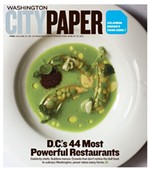How the West Was Wan
Cowboys and Indians—now more politely dubbed “the Western”—is an adventure genre nearly as old as the arrival of European colonists in the Americas. It’s no longer possible, of course, to present the encounter as one between civilization and savagery, but most attempts to replace the old paradigm with a more sensitive one have been either silly or shallow.
Terrence Malick’s The New World is neither, but the film accepts more of the old Pocahontas legend than might be expected, responding not with a countermyth but with lyricism and ambiguity. Given the week’s other cowboys-and-Indians flick, however, that doesn’t seem like such a bad option: Jim Hanon’s End of the Spear, a tale of Christian missionaries in the Amazon basin, is so sure of its message that it writes lucidity out of the story.
Writer-director Malick has made only four films in his career, and he took a 20-year break between the earlier two, 1974’s Badlands and 1978’s Days of Heaven, and the first of the second pair, 1998’s The Thin Red Line. Not surprisingly, the ’70s movies resemble each other more than they do the later ones. They’re earthier, more amenable to irony, and significantly tighter; both run under 100 minutes, while The Thin Red Line clocks in at 170 and The New World at 150. Or it did when it played a weeklong Oscar-qualifying engagement last month in New York and Los Angeles late last year. It’s been cut by 15 minutes for its general release, which poses an unusual problem: I haven’t actually seen the movie I’m reviewing.
That is, I’ve seen the 150-minute version. (A screening of the shorter rendition has been scheduled, but it will be too late for the Washington City Paper’s deadline.) Reportedly, rather than losing whole scenes, Malick compressed the film with a multitude of slight trims. (He’s also preparing a three-hour edition for DVD.) So though both edits tell the same story, it’s impossible for me to say whether they have the same feel.
That’s significant, because The New World is mostly feel. It contains a version of the story that most American schoolchildren know, and which Disney turned into an animated ecofable a decade ago: British colonizers arrive in an unspoiled Virginia in 1607, allowing bad boy John Smith (Colin Farrell) to meet the native princess (Q’orianka Kilcher) whom this film doesn’t name Pocahontas. She saves his life and they fall in love, but he departs. Later, she marries newcomer John Rolfe (Christian Bale) and travels to England, where she dies. This national fable, it should be pointed out, is presented with no great enthusiasm. As in The Thin Red Line, the director is less interested in the events than in the setting.
The movie opens with shots of light, water, and reflections, as Kilcher’s voice implores a spirit to help “sing the story of our land.” That appears to be what Malick is attempting: rendering the unknown territory as a series of poetic glimmers and burbling sounds. (Although James Horner’s score or some borrowed Wagner periodically drowns out the latter.) The New World uses the cinematic language of urgency—jump cuts, oblique angles, quick fades to black to end scenes that don’t seem to be quite over—to create a narrative that has no drive whatsoever. Things happen, including one bizarre aside in which the long-absent Smith suddenly materializes, looking for the Northwest Passage, only to promptly vanish. Yet even during battles between the colonizers and the people they call “the naturals,” the action feels suspended, a ghost waltz amid tidewater fog.
The relationship between Smith and the unnamed girl is particularly dancelike. The two circle each other rhapsodically, celebrating their amorous perceptions in amplified thoughts. (For the record, historians don’t think that the real Smith and Pocahontas were lovers.) The language gap is presented not as a practical difficulty—everyone speaks English when necessary—but as a theatrical conceit. The brooding characters talk mostly to themselves (and, of course, to the audience). Voice-over has always been central to Malick’s style, but in the brilliantly deadpan, widely influential Badlands, the commentary undercut the adolescent self-importance of the central characters. Here, the voice-overs are of a piece with the events being shown on screen: The New World is the rapturous tale of people behaving rapturously while indulging rapturous thoughts. Malick no longer does counterpoint.
OK, maybe some. Both of Malick’s later films include battle scenes whose violence plays against a bucolic setting. (The Thin Red Line depicts an American attack on Japanese troops who hold an enchanted Pacific island.) But the contrast between petty, transitory human events and grand, omnipresent nature has no weight, because the director doesn’t appear to care about the human side of his own formulation. Farrell, Kilcher, and Bale (as well as the underused Christopher Plummer and David Thewlis) wander this wonderland as if they were the spirits of the opening invocation, and they’re continually upstaged by parrots, shadows, and breezes.
Or at least that’s what happens in the 150-minute version. For the shorter one, Malick has most likely pruned the vaporous imagery to focus on the indifferent storytelling. That might seem a logical strategy, but it’s not going to work: You can’t shape haze, and The New World is a lovely, inexpressive curl of mist.

